Analysis of Geopolymer Concrete for Perpetual Pavement Construction
VerifiedAdded on 2020/02/24
|55
|13235
|395
Report
AI Summary
This report examines the application of geopolymer concrete in the construction of perpetual pavements, focusing on its potential as a sustainable alternative to traditional Portland cement concrete. The study delves into the background of geopolymer technology, its environmental benefits, and the properties of geopolymer concrete. It covers the materials used, including fly ash and other additives, along with the methods of concrete mix design and experimental procedures. The methodology includes detailed processes, performance analysis, and comparisons of experimental results with theoretical expectations. The report also includes analysis of chemical compositions, fresh geopolymer analysis, physical and mechanical properties, and morphological analysis. The discussion and analysis sections explore the relationship between flexural and compressive strengths, culminating in conclusions regarding the viability and advantages of geopolymer concrete in pavement applications. The report also includes references to provide a comprehensive overview of the topic.
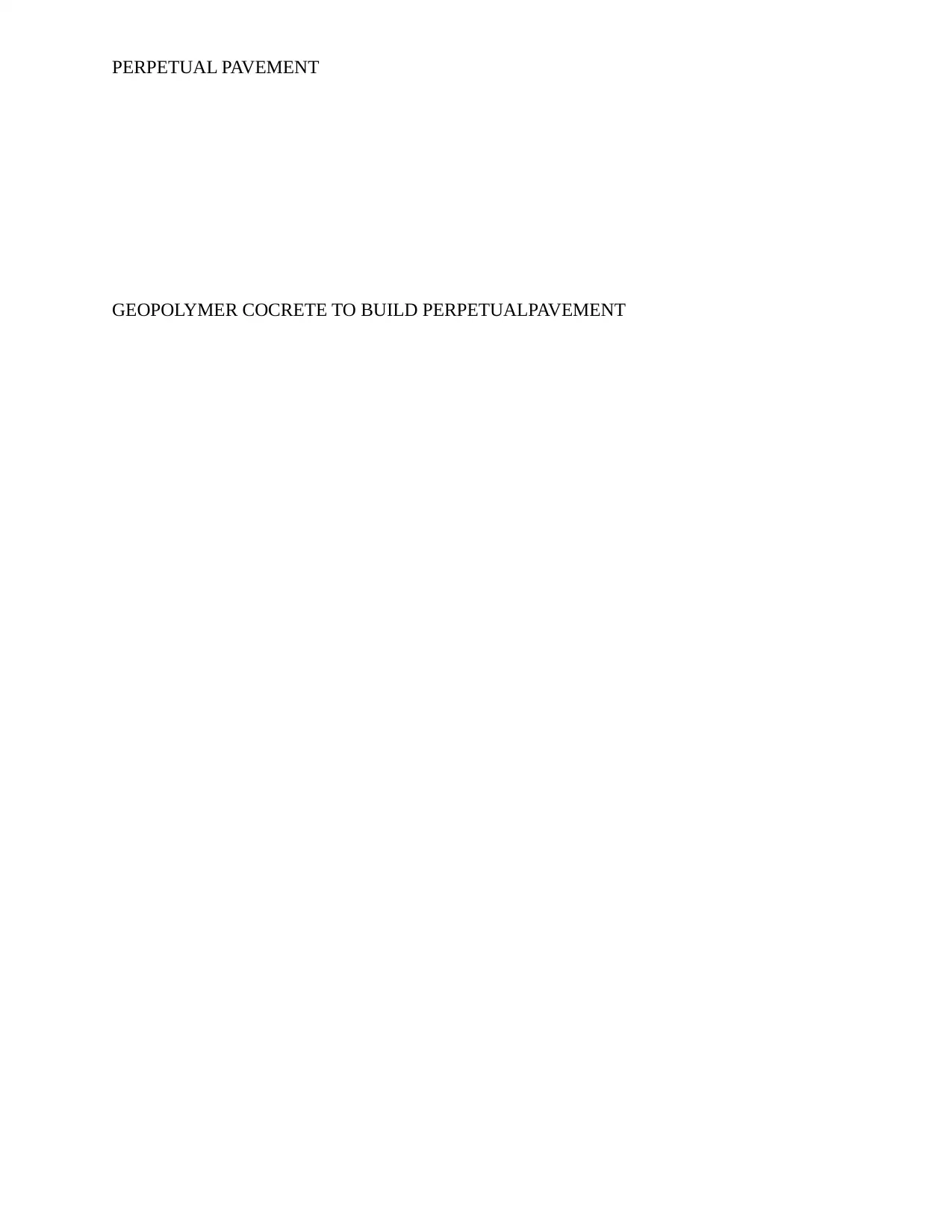
PERPETUAL PAVEMENT
GEOPOLYMER COCRETE TO BUILD PERPETUALPAVEMENT
GEOPOLYMER COCRETE TO BUILD PERPETUALPAVEMENT
Paraphrase This Document
Need a fresh take? Get an instant paraphrase of this document with our AI Paraphraser
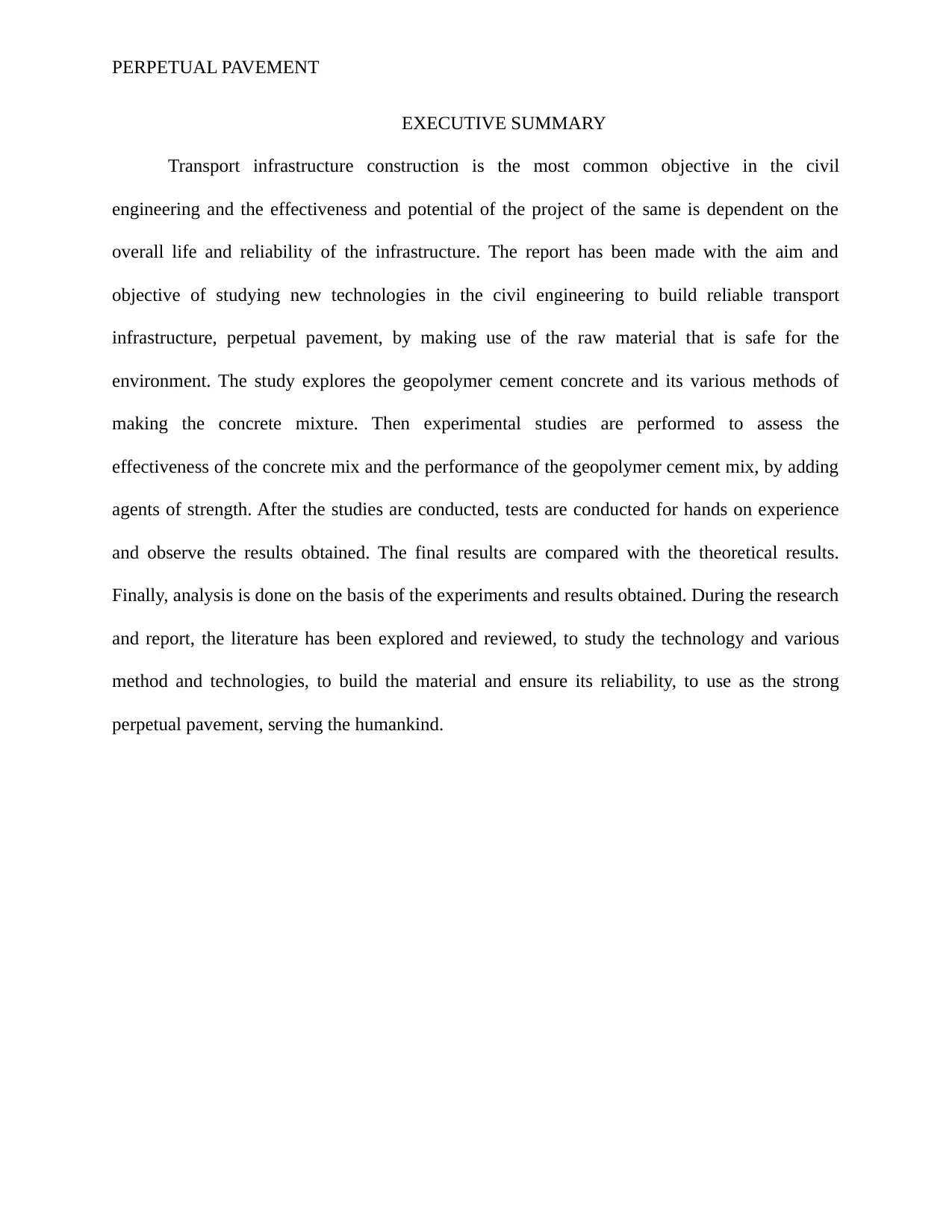
PERPETUAL PAVEMENT
EXECUTIVE SUMMARY
Transport infrastructure construction is the most common objective in the civil
engineering and the effectiveness and potential of the project of the same is dependent on the
overall life and reliability of the infrastructure. The report has been made with the aim and
objective of studying new technologies in the civil engineering to build reliable transport
infrastructure, perpetual pavement, by making use of the raw material that is safe for the
environment. The study explores the geopolymer cement concrete and its various methods of
making the concrete mixture. Then experimental studies are performed to assess the
effectiveness of the concrete mix and the performance of the geopolymer cement mix, by adding
agents of strength. After the studies are conducted, tests are conducted for hands on experience
and observe the results obtained. The final results are compared with the theoretical results.
Finally, analysis is done on the basis of the experiments and results obtained. During the research
and report, the literature has been explored and reviewed, to study the technology and various
method and technologies, to build the material and ensure its reliability, to use as the strong
perpetual pavement, serving the humankind.
EXECUTIVE SUMMARY
Transport infrastructure construction is the most common objective in the civil
engineering and the effectiveness and potential of the project of the same is dependent on the
overall life and reliability of the infrastructure. The report has been made with the aim and
objective of studying new technologies in the civil engineering to build reliable transport
infrastructure, perpetual pavement, by making use of the raw material that is safe for the
environment. The study explores the geopolymer cement concrete and its various methods of
making the concrete mixture. Then experimental studies are performed to assess the
effectiveness of the concrete mix and the performance of the geopolymer cement mix, by adding
agents of strength. After the studies are conducted, tests are conducted for hands on experience
and observe the results obtained. The final results are compared with the theoretical results.
Finally, analysis is done on the basis of the experiments and results obtained. During the research
and report, the literature has been explored and reviewed, to study the technology and various
method and technologies, to build the material and ensure its reliability, to use as the strong
perpetual pavement, serving the humankind.
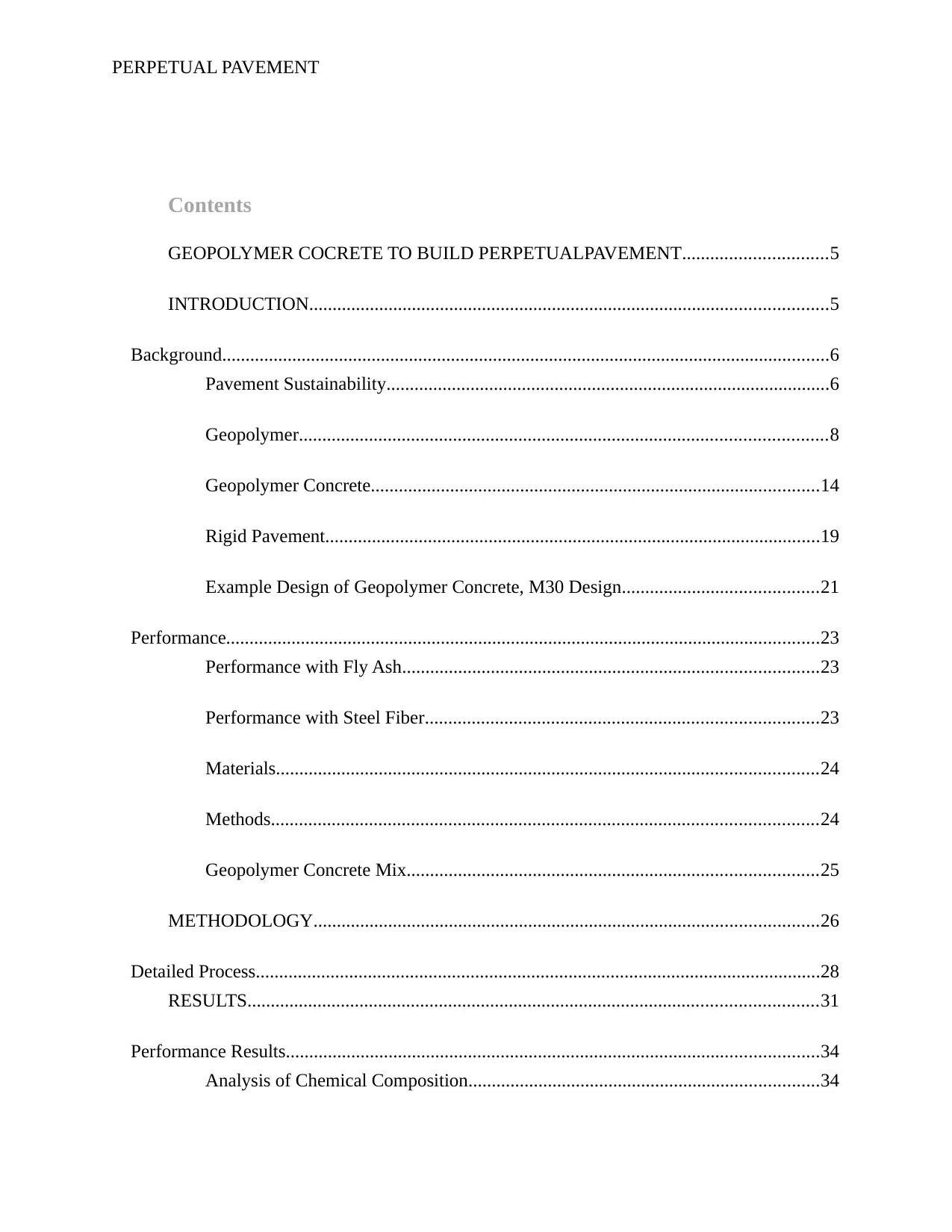
PERPETUAL PAVEMENT
Contents
GEOPOLYMER COCRETE TO BUILD PERPETUALPAVEMENT...............................5
INTRODUCTION...............................................................................................................5
Background..................................................................................................................................6
Pavement Sustainability...............................................................................................6
Geopolymer.................................................................................................................8
Geopolymer Concrete................................................................................................14
Rigid Pavement..........................................................................................................19
Example Design of Geopolymer Concrete, M30 Design..........................................21
Performance...............................................................................................................................23
Performance with Fly Ash.........................................................................................23
Performance with Steel Fiber....................................................................................23
Materials....................................................................................................................24
Methods.....................................................................................................................24
Geopolymer Concrete Mix........................................................................................25
METHODOLOGY............................................................................................................26
Detailed Process.........................................................................................................................28
RESULTS..........................................................................................................................31
Performance Results..................................................................................................................34
Analysis of Chemical Composition...........................................................................34
Contents
GEOPOLYMER COCRETE TO BUILD PERPETUALPAVEMENT...............................5
INTRODUCTION...............................................................................................................5
Background..................................................................................................................................6
Pavement Sustainability...............................................................................................6
Geopolymer.................................................................................................................8
Geopolymer Concrete................................................................................................14
Rigid Pavement..........................................................................................................19
Example Design of Geopolymer Concrete, M30 Design..........................................21
Performance...............................................................................................................................23
Performance with Fly Ash.........................................................................................23
Performance with Steel Fiber....................................................................................23
Materials....................................................................................................................24
Methods.....................................................................................................................24
Geopolymer Concrete Mix........................................................................................25
METHODOLOGY............................................................................................................26
Detailed Process.........................................................................................................................28
RESULTS..........................................................................................................................31
Performance Results..................................................................................................................34
Analysis of Chemical Composition...........................................................................34
⊘ This is a preview!⊘
Do you want full access?
Subscribe today to unlock all pages.

Trusted by 1+ million students worldwide
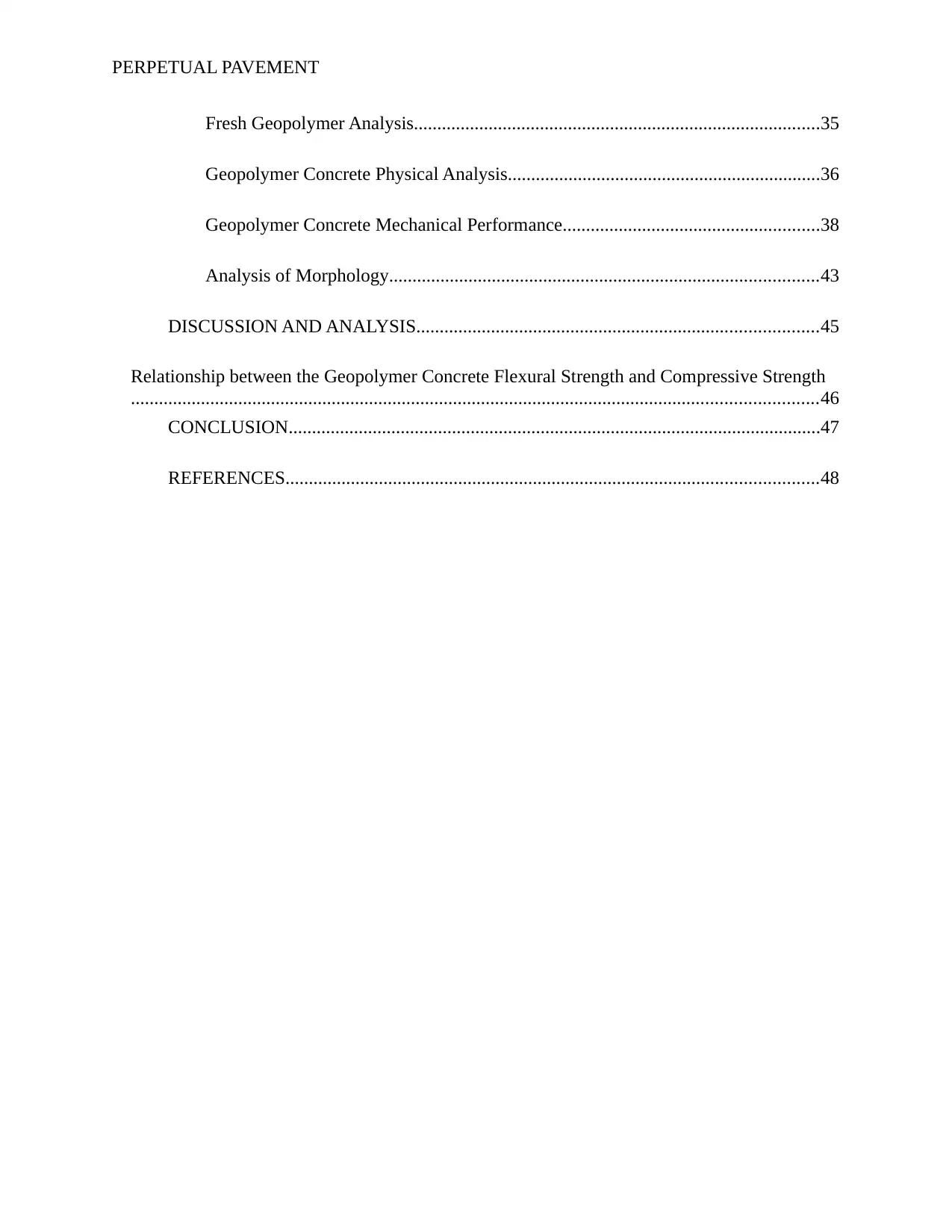
PERPETUAL PAVEMENT
Fresh Geopolymer Analysis.......................................................................................35
Geopolymer Concrete Physical Analysis...................................................................36
Geopolymer Concrete Mechanical Performance.......................................................38
Analysis of Morphology............................................................................................43
DISCUSSION AND ANALYSIS......................................................................................45
Relationship between the Geopolymer Concrete Flexural Strength and Compressive Strength
...................................................................................................................................................46
CONCLUSION..................................................................................................................47
REFERENCES..................................................................................................................48
Fresh Geopolymer Analysis.......................................................................................35
Geopolymer Concrete Physical Analysis...................................................................36
Geopolymer Concrete Mechanical Performance.......................................................38
Analysis of Morphology............................................................................................43
DISCUSSION AND ANALYSIS......................................................................................45
Relationship between the Geopolymer Concrete Flexural Strength and Compressive Strength
...................................................................................................................................................46
CONCLUSION..................................................................................................................47
REFERENCES..................................................................................................................48
Paraphrase This Document
Need a fresh take? Get an instant paraphrase of this document with our AI Paraphraser
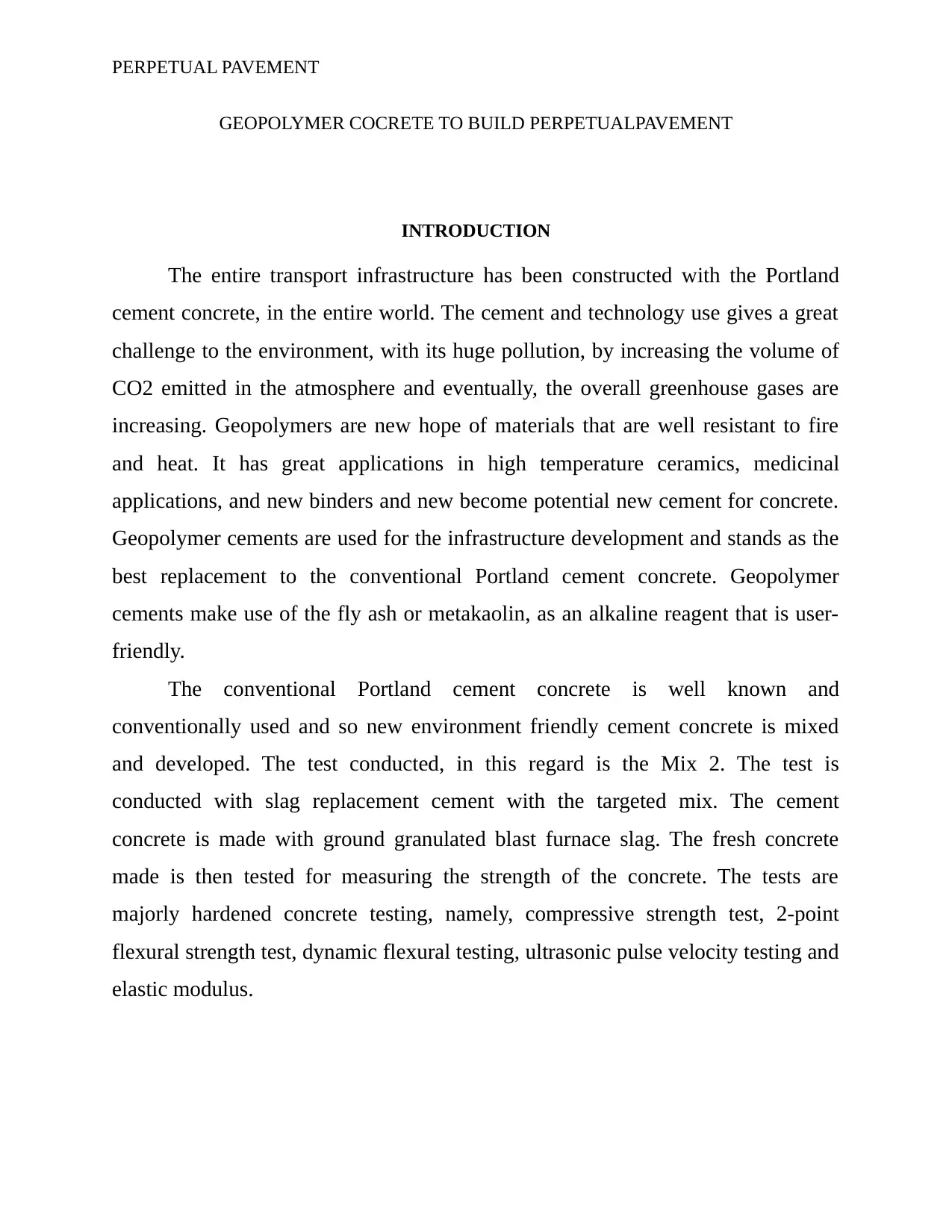
PERPETUAL PAVEMENT
GEOPOLYMER COCRETE TO BUILD PERPETUALPAVEMENT
INTRODUCTION
The entire transport infrastructure has been constructed with the Portland
cement concrete, in the entire world. The cement and technology use gives a great
challenge to the environment, with its huge pollution, by increasing the volume of
CO2 emitted in the atmosphere and eventually, the overall greenhouse gases are
increasing. Geopolymers are new hope of materials that are well resistant to fire
and heat. It has great applications in high temperature ceramics, medicinal
applications, and new binders and new become potential new cement for concrete.
Geopolymer cements are used for the infrastructure development and stands as the
best replacement to the conventional Portland cement concrete. Geopolymer
cements make use of the fly ash or metakaolin, as an alkaline reagent that is user-
friendly.
The conventional Portland cement concrete is well known and
conventionally used and so new environment friendly cement concrete is mixed
and developed. The test conducted, in this regard is the Mix 2. The test is
conducted with slag replacement cement with the targeted mix. The cement
concrete is made with ground granulated blast furnace slag. The fresh concrete
made is then tested for measuring the strength of the concrete. The tests are
majorly hardened concrete testing, namely, compressive strength test, 2-point
flexural strength test, dynamic flexural testing, ultrasonic pulse velocity testing and
elastic modulus.
GEOPOLYMER COCRETE TO BUILD PERPETUALPAVEMENT
INTRODUCTION
The entire transport infrastructure has been constructed with the Portland
cement concrete, in the entire world. The cement and technology use gives a great
challenge to the environment, with its huge pollution, by increasing the volume of
CO2 emitted in the atmosphere and eventually, the overall greenhouse gases are
increasing. Geopolymers are new hope of materials that are well resistant to fire
and heat. It has great applications in high temperature ceramics, medicinal
applications, and new binders and new become potential new cement for concrete.
Geopolymer cements are used for the infrastructure development and stands as the
best replacement to the conventional Portland cement concrete. Geopolymer
cements make use of the fly ash or metakaolin, as an alkaline reagent that is user-
friendly.
The conventional Portland cement concrete is well known and
conventionally used and so new environment friendly cement concrete is mixed
and developed. The test conducted, in this regard is the Mix 2. The test is
conducted with slag replacement cement with the targeted mix. The cement
concrete is made with ground granulated blast furnace slag. The fresh concrete
made is then tested for measuring the strength of the concrete. The tests are
majorly hardened concrete testing, namely, compressive strength test, 2-point
flexural strength test, dynamic flexural testing, ultrasonic pulse velocity testing and
elastic modulus.
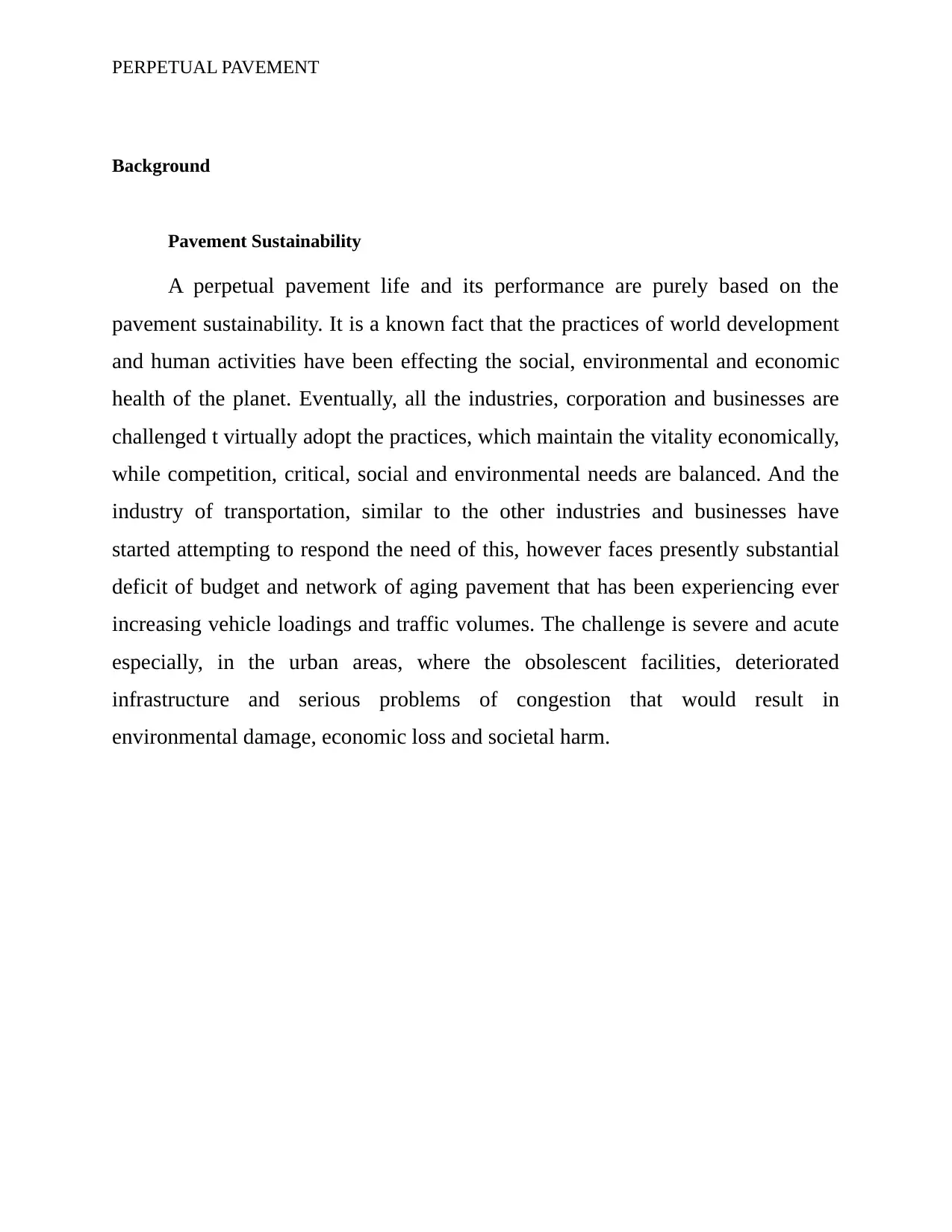
PERPETUAL PAVEMENT
Background
Pavement Sustainability
A perpetual pavement life and its performance are purely based on the
pavement sustainability. It is a known fact that the practices of world development
and human activities have been effecting the social, environmental and economic
health of the planet. Eventually, all the industries, corporation and businesses are
challenged t virtually adopt the practices, which maintain the vitality economically,
while competition, critical, social and environmental needs are balanced. And the
industry of transportation, similar to the other industries and businesses have
started attempting to respond the need of this, however faces presently substantial
deficit of budget and network of aging pavement that has been experiencing ever
increasing vehicle loadings and traffic volumes. The challenge is severe and acute
especially, in the urban areas, where the obsolescent facilities, deteriorated
infrastructure and serious problems of congestion that would result in
environmental damage, economic loss and societal harm.
Background
Pavement Sustainability
A perpetual pavement life and its performance are purely based on the
pavement sustainability. It is a known fact that the practices of world development
and human activities have been effecting the social, environmental and economic
health of the planet. Eventually, all the industries, corporation and businesses are
challenged t virtually adopt the practices, which maintain the vitality economically,
while competition, critical, social and environmental needs are balanced. And the
industry of transportation, similar to the other industries and businesses have
started attempting to respond the need of this, however faces presently substantial
deficit of budget and network of aging pavement that has been experiencing ever
increasing vehicle loadings and traffic volumes. The challenge is severe and acute
especially, in the urban areas, where the obsolescent facilities, deteriorated
infrastructure and serious problems of congestion that would result in
environmental damage, economic loss and societal harm.
⊘ This is a preview!⊘
Do you want full access?
Subscribe today to unlock all pages.

Trusted by 1+ million students worldwide
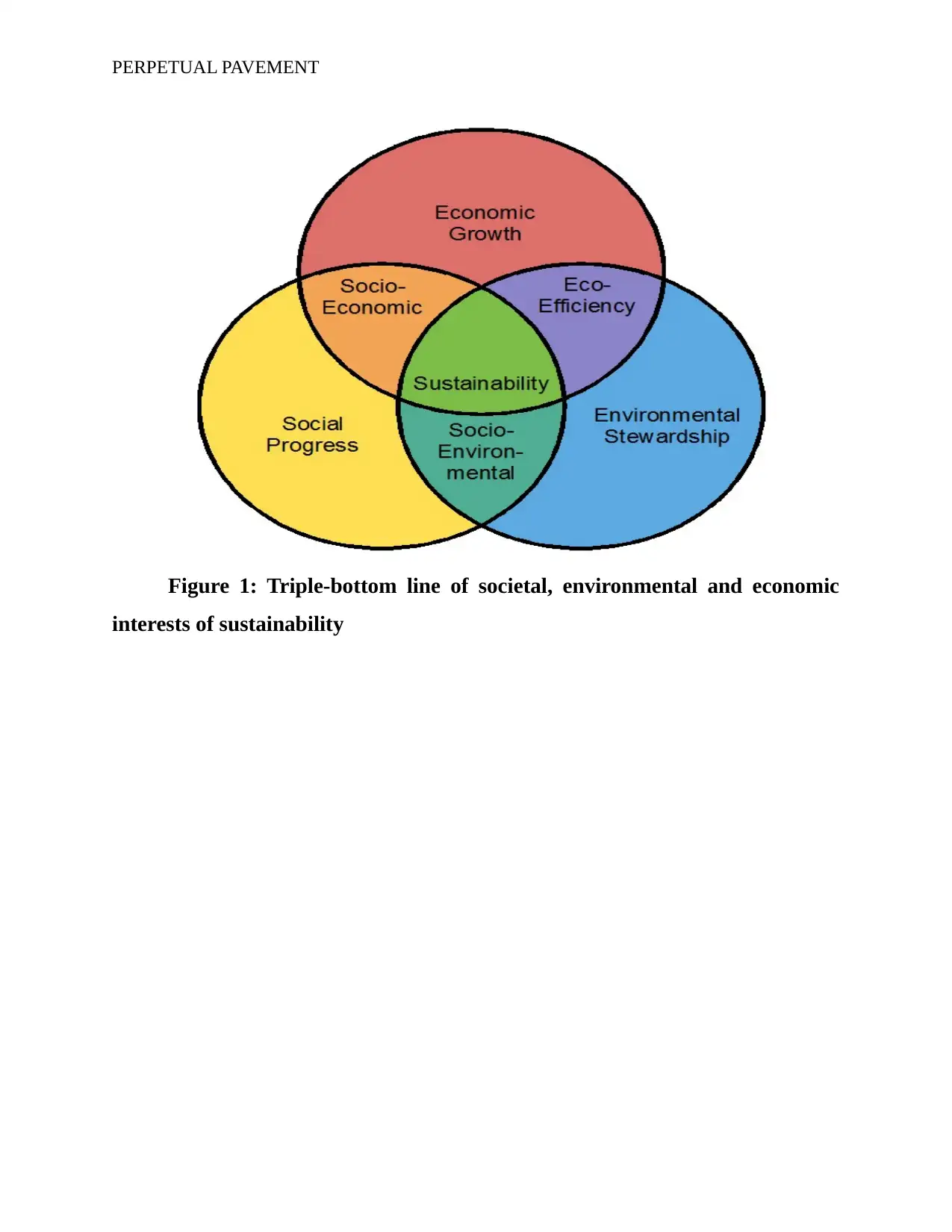
PERPETUAL PAVEMENT
Figure 1: Triple-bottom line of societal, environmental and economic
interests of sustainability
Figure 1: Triple-bottom line of societal, environmental and economic
interests of sustainability
Paraphrase This Document
Need a fresh take? Get an instant paraphrase of this document with our AI Paraphraser
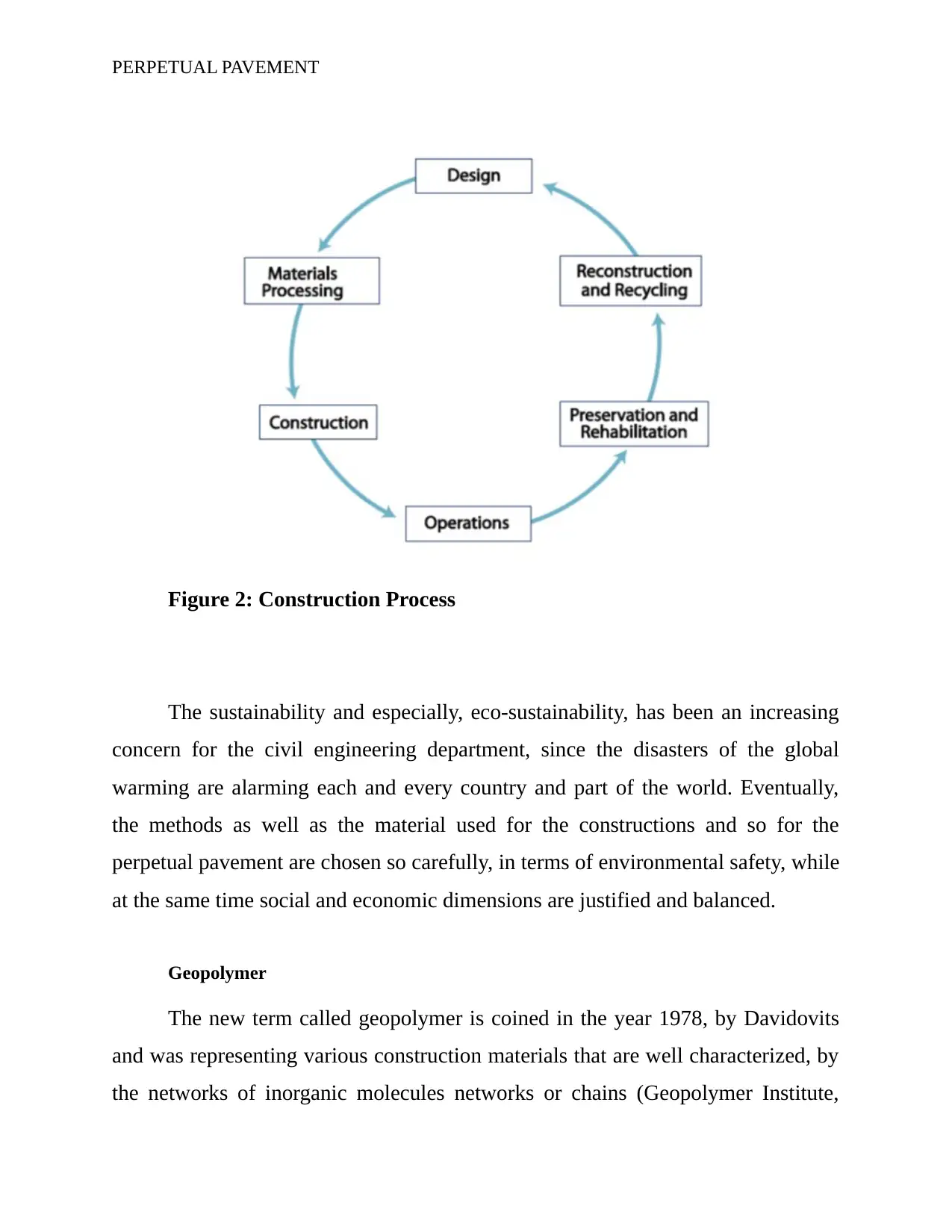
PERPETUAL PAVEMENT
Figure 2: Construction Process
The sustainability and especially, eco-sustainability, has been an increasing
concern for the civil engineering department, since the disasters of the global
warming are alarming each and every country and part of the world. Eventually,
the methods as well as the material used for the constructions and so for the
perpetual pavement are chosen so carefully, in terms of environmental safety, while
at the same time social and economic dimensions are justified and balanced.
Geopolymer
The new term called geopolymer is coined in the year 1978, by Davidovits
and was representing various construction materials that are well characterized, by
the networks of inorganic molecules networks or chains (Geopolymer Institute,
Figure 2: Construction Process
The sustainability and especially, eco-sustainability, has been an increasing
concern for the civil engineering department, since the disasters of the global
warming are alarming each and every country and part of the world. Eventually,
the methods as well as the material used for the constructions and so for the
perpetual pavement are chosen so carefully, in terms of environmental safety, while
at the same time social and economic dimensions are justified and balanced.
Geopolymer
The new term called geopolymer is coined in the year 1978, by Davidovits
and was representing various construction materials that are well characterized, by
the networks of inorganic molecules networks or chains (Geopolymer Institute,
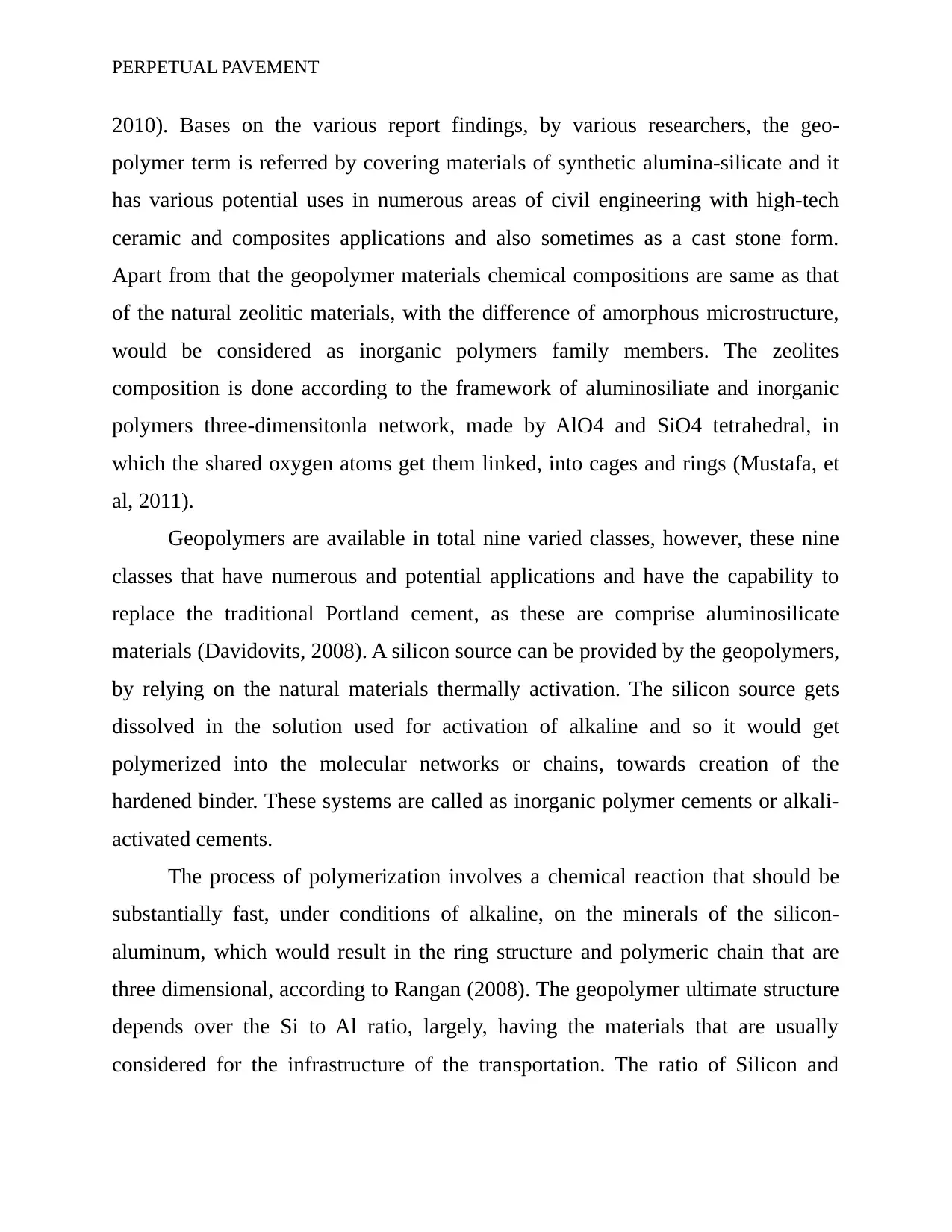
PERPETUAL PAVEMENT
2010). Bases on the various report findings, by various researchers, the geo-
polymer term is referred by covering materials of synthetic alumina-silicate and it
has various potential uses in numerous areas of civil engineering with high-tech
ceramic and composites applications and also sometimes as a cast stone form.
Apart from that the geopolymer materials chemical compositions are same as that
of the natural zeolitic materials, with the difference of amorphous microstructure,
would be considered as inorganic polymers family members. The zeolites
composition is done according to the framework of aluminosiliate and inorganic
polymers three-dimensitonla network, made by AlO4 and SiO4 tetrahedral, in
which the shared oxygen atoms get them linked, into cages and rings (Mustafa, et
al, 2011).
Geopolymers are available in total nine varied classes, however, these nine
classes that have numerous and potential applications and have the capability to
replace the traditional Portland cement, as these are comprise aluminosilicate
materials (Davidovits, 2008). A silicon source can be provided by the geopolymers,
by relying on the natural materials thermally activation. The silicon source gets
dissolved in the solution used for activation of alkaline and so it would get
polymerized into the molecular networks or chains, towards creation of the
hardened binder. These systems are called as inorganic polymer cements or alkali-
activated cements.
The process of polymerization involves a chemical reaction that should be
substantially fast, under conditions of alkaline, on the minerals of the silicon-
aluminum, which would result in the ring structure and polymeric chain that are
three dimensional, according to Rangan (2008). The geopolymer ultimate structure
depends over the Si to Al ratio, largely, having the materials that are usually
considered for the infrastructure of the transportation. The ratio of Silicon and
2010). Bases on the various report findings, by various researchers, the geo-
polymer term is referred by covering materials of synthetic alumina-silicate and it
has various potential uses in numerous areas of civil engineering with high-tech
ceramic and composites applications and also sometimes as a cast stone form.
Apart from that the geopolymer materials chemical compositions are same as that
of the natural zeolitic materials, with the difference of amorphous microstructure,
would be considered as inorganic polymers family members. The zeolites
composition is done according to the framework of aluminosiliate and inorganic
polymers three-dimensitonla network, made by AlO4 and SiO4 tetrahedral, in
which the shared oxygen atoms get them linked, into cages and rings (Mustafa, et
al, 2011).
Geopolymers are available in total nine varied classes, however, these nine
classes that have numerous and potential applications and have the capability to
replace the traditional Portland cement, as these are comprise aluminosilicate
materials (Davidovits, 2008). A silicon source can be provided by the geopolymers,
by relying on the natural materials thermally activation. The silicon source gets
dissolved in the solution used for activation of alkaline and so it would get
polymerized into the molecular networks or chains, towards creation of the
hardened binder. These systems are called as inorganic polymer cements or alkali-
activated cements.
The process of polymerization involves a chemical reaction that should be
substantially fast, under conditions of alkaline, on the minerals of the silicon-
aluminum, which would result in the ring structure and polymeric chain that are
three dimensional, according to Rangan (2008). The geopolymer ultimate structure
depends over the Si to Al ratio, largely, having the materials that are usually
considered for the infrastructure of the transportation. The ratio of Silicon and
⊘ This is a preview!⊘
Do you want full access?
Subscribe today to unlock all pages.

Trusted by 1+ million students worldwide
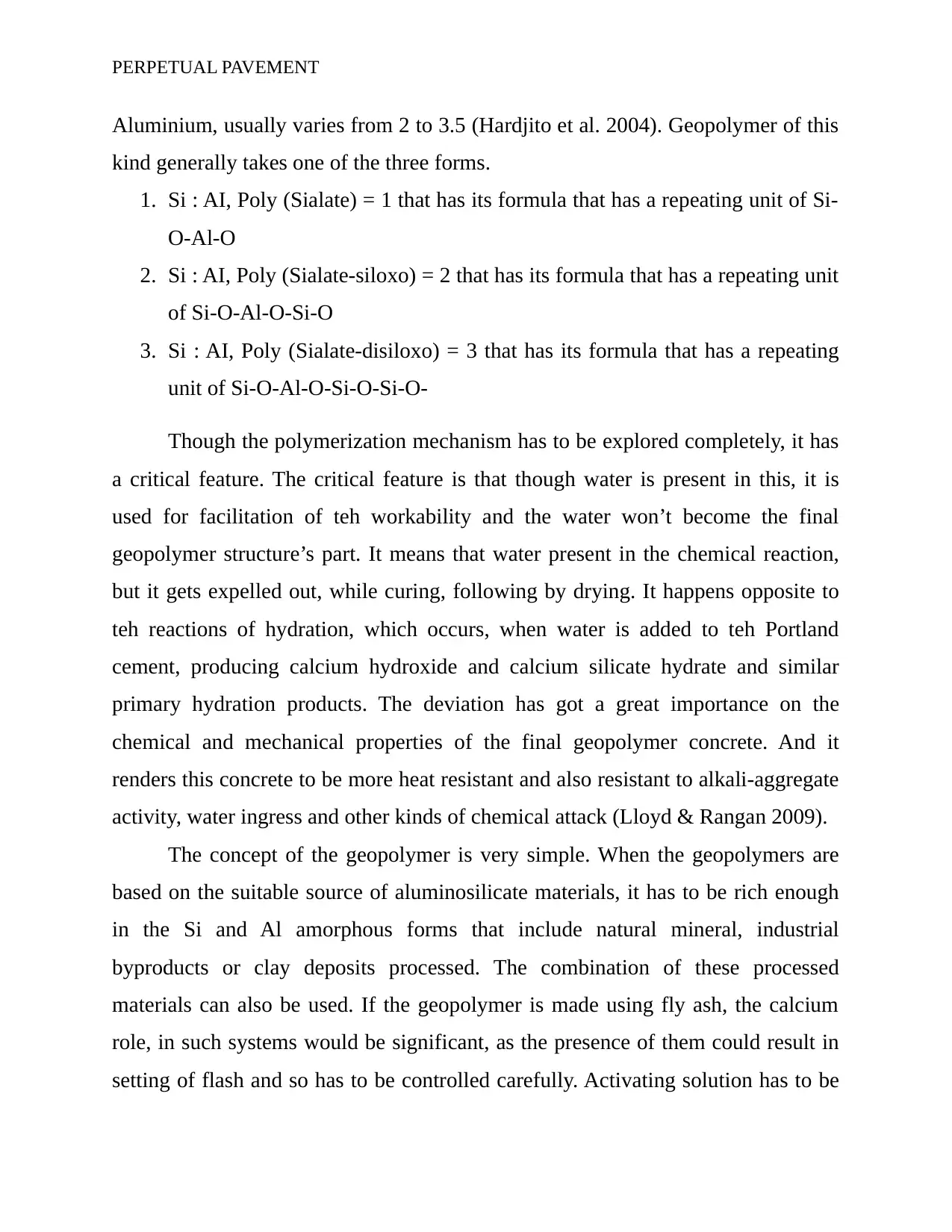
PERPETUAL PAVEMENT
Aluminium, usually varies from 2 to 3.5 (Hardjito et al. 2004). Geopolymer of this
kind generally takes one of the three forms.
1. Si : AI, Poly (Sialate) = 1 that has its formula that has a repeating unit of Si-
O-Al-O
2. Si : AI, Poly (Sialate-siloxo) = 2 that has its formula that has a repeating unit
of Si-O-Al-O-Si-O
3. Si : AI, Poly (Sialate-disiloxo) = 3 that has its formula that has a repeating
unit of Si-O-Al-O-Si-O-Si-O-
Though the polymerization mechanism has to be explored completely, it has
a critical feature. The critical feature is that though water is present in this, it is
used for facilitation of teh workability and the water won’t become the final
geopolymer structure’s part. It means that water present in the chemical reaction,
but it gets expelled out, while curing, following by drying. It happens opposite to
teh reactions of hydration, which occurs, when water is added to teh Portland
cement, producing calcium hydroxide and calcium silicate hydrate and similar
primary hydration products. The deviation has got a great importance on the
chemical and mechanical properties of the final geopolymer concrete. And it
renders this concrete to be more heat resistant and also resistant to alkali-aggregate
activity, water ingress and other kinds of chemical attack (Lloyd & Rangan 2009).
The concept of the geopolymer is very simple. When the geopolymers are
based on the suitable source of aluminosilicate materials, it has to be rich enough
in the Si and Al amorphous forms that include natural mineral, industrial
byproducts or clay deposits processed. The combination of these processed
materials can also be used. If the geopolymer is made using fly ash, the calcium
role, in such systems would be significant, as the presence of them could result in
setting of flash and so has to be controlled carefully. Activating solution has to be
Aluminium, usually varies from 2 to 3.5 (Hardjito et al. 2004). Geopolymer of this
kind generally takes one of the three forms.
1. Si : AI, Poly (Sialate) = 1 that has its formula that has a repeating unit of Si-
O-Al-O
2. Si : AI, Poly (Sialate-siloxo) = 2 that has its formula that has a repeating unit
of Si-O-Al-O-Si-O
3. Si : AI, Poly (Sialate-disiloxo) = 3 that has its formula that has a repeating
unit of Si-O-Al-O-Si-O-Si-O-
Though the polymerization mechanism has to be explored completely, it has
a critical feature. The critical feature is that though water is present in this, it is
used for facilitation of teh workability and the water won’t become the final
geopolymer structure’s part. It means that water present in the chemical reaction,
but it gets expelled out, while curing, following by drying. It happens opposite to
teh reactions of hydration, which occurs, when water is added to teh Portland
cement, producing calcium hydroxide and calcium silicate hydrate and similar
primary hydration products. The deviation has got a great importance on the
chemical and mechanical properties of the final geopolymer concrete. And it
renders this concrete to be more heat resistant and also resistant to alkali-aggregate
activity, water ingress and other kinds of chemical attack (Lloyd & Rangan 2009).
The concept of the geopolymer is very simple. When the geopolymers are
based on the suitable source of aluminosilicate materials, it has to be rich enough
in the Si and Al amorphous forms that include natural mineral, industrial
byproducts or clay deposits processed. The combination of these processed
materials can also be used. If the geopolymer is made using fly ash, the calcium
role, in such systems would be significant, as the presence of them could result in
setting of flash and so has to be controlled carefully. Activating solution has to be
Paraphrase This Document
Need a fresh take? Get an instant paraphrase of this document with our AI Paraphraser
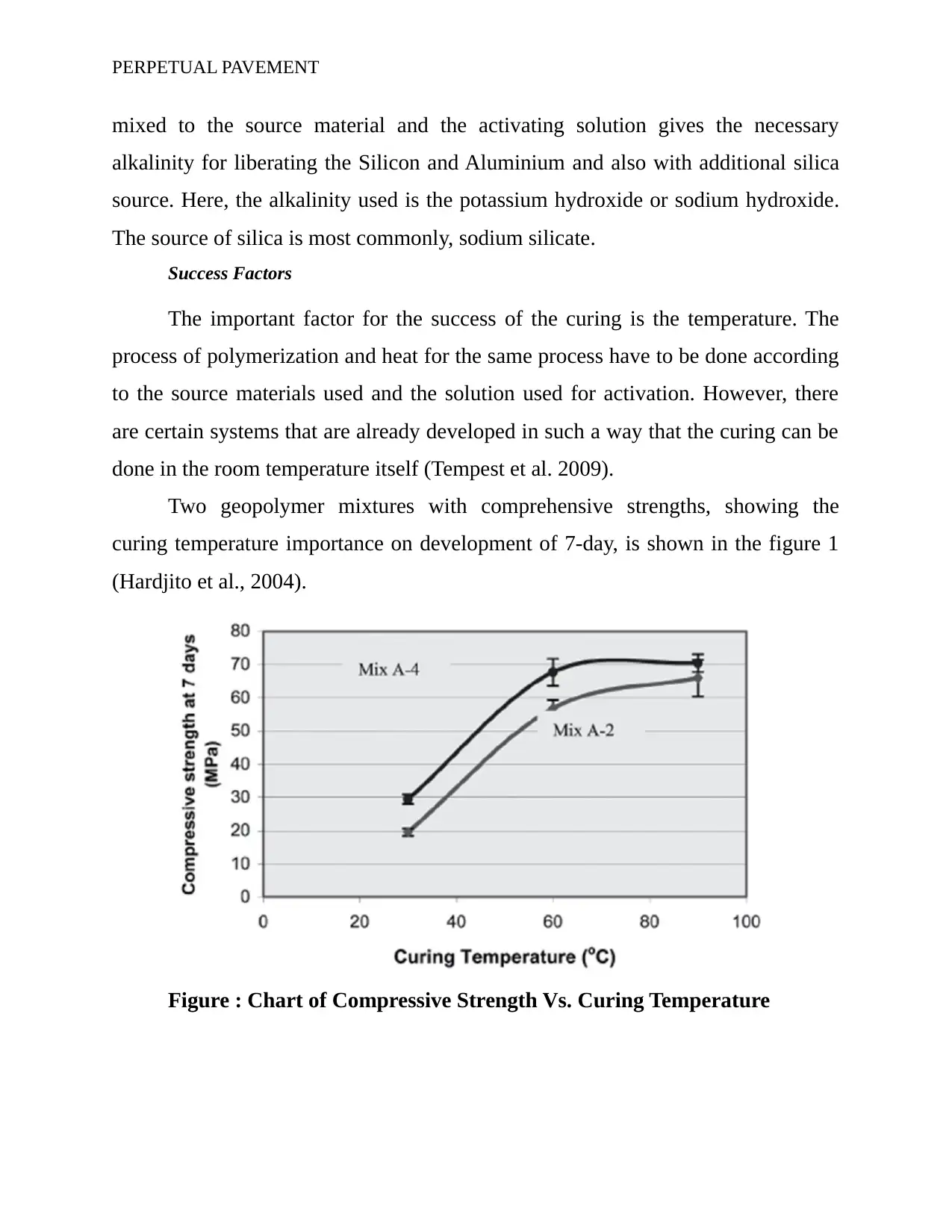
PERPETUAL PAVEMENT
mixed to the source material and the activating solution gives the necessary
alkalinity for liberating the Silicon and Aluminium and also with additional silica
source. Here, the alkalinity used is the potassium hydroxide or sodium hydroxide.
The source of silica is most commonly, sodium silicate.
Success Factors
The important factor for the success of the curing is the temperature. The
process of polymerization and heat for the same process have to be done according
to the source materials used and the solution used for activation. However, there
are certain systems that are already developed in such a way that the curing can be
done in the room temperature itself (Tempest et al. 2009).
Two geopolymer mixtures with comprehensive strengths, showing the
curing temperature importance on development of 7-day, is shown in the figure 1
(Hardjito et al., 2004).
Figure : Chart of Compressive Strength Vs. Curing Temperature
mixed to the source material and the activating solution gives the necessary
alkalinity for liberating the Silicon and Aluminium and also with additional silica
source. Here, the alkalinity used is the potassium hydroxide or sodium hydroxide.
The source of silica is most commonly, sodium silicate.
Success Factors
The important factor for the success of the curing is the temperature. The
process of polymerization and heat for the same process have to be done according
to the source materials used and the solution used for activation. However, there
are certain systems that are already developed in such a way that the curing can be
done in the room temperature itself (Tempest et al. 2009).
Two geopolymer mixtures with comprehensive strengths, showing the
curing temperature importance on development of 7-day, is shown in the figure 1
(Hardjito et al., 2004).
Figure : Chart of Compressive Strength Vs. Curing Temperature
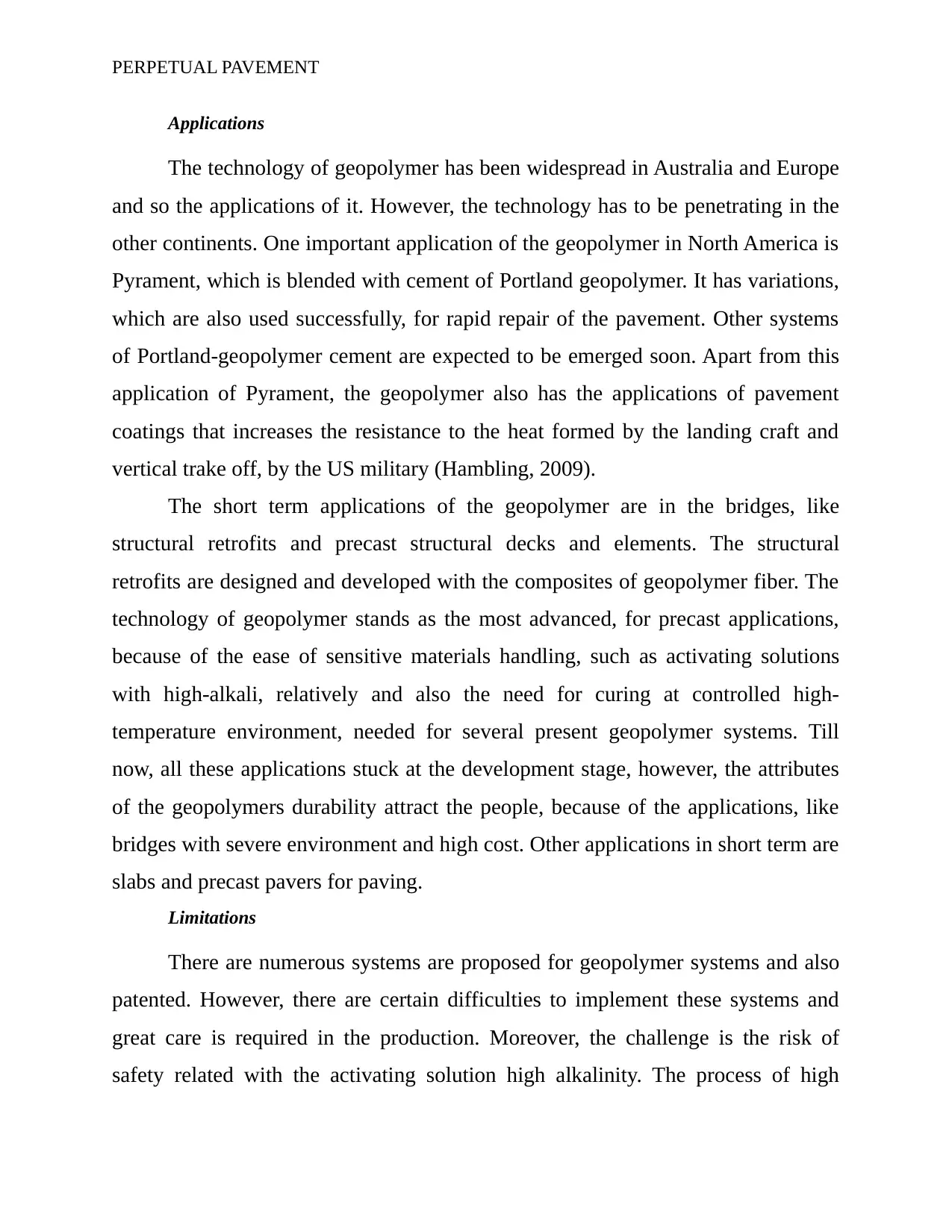
PERPETUAL PAVEMENT
Applications
The technology of geopolymer has been widespread in Australia and Europe
and so the applications of it. However, the technology has to be penetrating in the
other continents. One important application of the geopolymer in North America is
Pyrament, which is blended with cement of Portland geopolymer. It has variations,
which are also used successfully, for rapid repair of the pavement. Other systems
of Portland-geopolymer cement are expected to be emerged soon. Apart from this
application of Pyrament, the geopolymer also has the applications of pavement
coatings that increases the resistance to the heat formed by the landing craft and
vertical trake off, by the US military (Hambling, 2009).
The short term applications of the geopolymer are in the bridges, like
structural retrofits and precast structural decks and elements. The structural
retrofits are designed and developed with the composites of geopolymer fiber. The
technology of geopolymer stands as the most advanced, for precast applications,
because of the ease of sensitive materials handling, such as activating solutions
with high-alkali, relatively and also the need for curing at controlled high-
temperature environment, needed for several present geopolymer systems. Till
now, all these applications stuck at the development stage, however, the attributes
of the geopolymers durability attract the people, because of the applications, like
bridges with severe environment and high cost. Other applications in short term are
slabs and precast pavers for paving.
Limitations
There are numerous systems are proposed for geopolymer systems and also
patented. However, there are certain difficulties to implement these systems and
great care is required in the production. Moreover, the challenge is the risk of
safety related with the activating solution high alkalinity. The process of high
Applications
The technology of geopolymer has been widespread in Australia and Europe
and so the applications of it. However, the technology has to be penetrating in the
other continents. One important application of the geopolymer in North America is
Pyrament, which is blended with cement of Portland geopolymer. It has variations,
which are also used successfully, for rapid repair of the pavement. Other systems
of Portland-geopolymer cement are expected to be emerged soon. Apart from this
application of Pyrament, the geopolymer also has the applications of pavement
coatings that increases the resistance to the heat formed by the landing craft and
vertical trake off, by the US military (Hambling, 2009).
The short term applications of the geopolymer are in the bridges, like
structural retrofits and precast structural decks and elements. The structural
retrofits are designed and developed with the composites of geopolymer fiber. The
technology of geopolymer stands as the most advanced, for precast applications,
because of the ease of sensitive materials handling, such as activating solutions
with high-alkali, relatively and also the need for curing at controlled high-
temperature environment, needed for several present geopolymer systems. Till
now, all these applications stuck at the development stage, however, the attributes
of the geopolymers durability attract the people, because of the applications, like
bridges with severe environment and high cost. Other applications in short term are
slabs and precast pavers for paving.
Limitations
There are numerous systems are proposed for geopolymer systems and also
patented. However, there are certain difficulties to implement these systems and
great care is required in the production. Moreover, the challenge is the risk of
safety related with the activating solution high alkalinity. The process of high
⊘ This is a preview!⊘
Do you want full access?
Subscribe today to unlock all pages.

Trusted by 1+ million students worldwide
1 out of 55
Related Documents
Your All-in-One AI-Powered Toolkit for Academic Success.
+13062052269
info@desklib.com
Available 24*7 on WhatsApp / Email
![[object Object]](/_next/static/media/star-bottom.7253800d.svg)
Unlock your academic potential
Copyright © 2020–2025 A2Z Services. All Rights Reserved. Developed and managed by ZUCOL.




